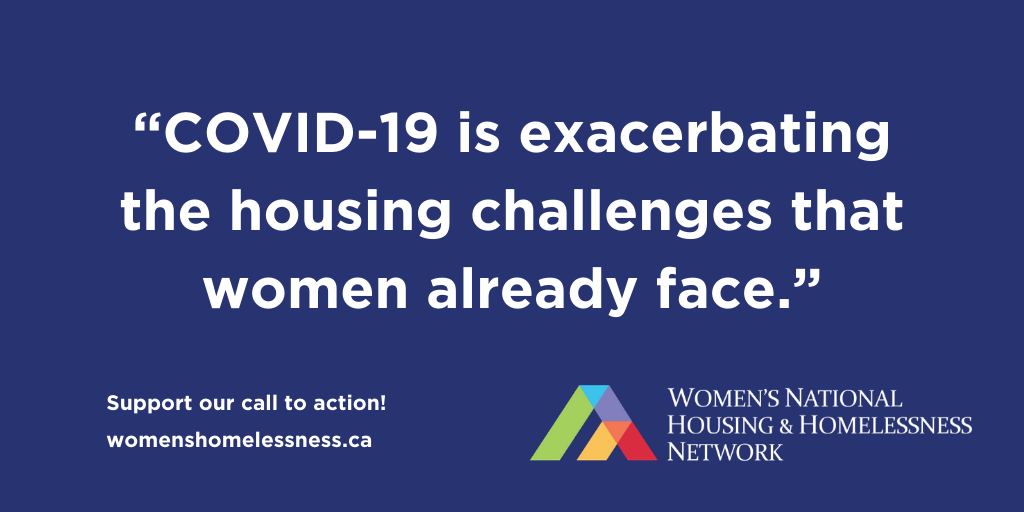The Women’s National Housing & Homelessness Network is urging all levels of government to implement nine measures to protect women, girls, children and gender-diverse peoples experiencing homelessness and domestic violence during the COVID-19 pandemic.
 Women’s homelessness in Canada was already a crisis before this pandemic. Now more than ever, women, girls and gender-diverse people need access to adequate and safe housing. For many it is the difference between life and death.
Women’s homelessness in Canada was already a crisis before this pandemic. Now more than ever, women, girls and gender-diverse people need access to adequate and safe housing. For many it is the difference between life and death.
The WNHHN outlines nine measures needed for a gender-informed response, including: immediate provision of safe and adequate housing for those experiencing homelessness and/or fleeing violence, a moratorium on all evictions, the acquisition of hotels/motels for emergency housing, and the formation of a diverse national advisory body to ensure policy responses are gender-informed and shaped by lived experts—read the full call to action here.
“COVID-19 is exacerbating the housing challenges that women already face,” says Kaitlin Schwan, WNHHN Co-chair. “COVID-19 is a gendered crisis. Women are more likely to live in core housing need, experience poverty, be laid off from poor-paying service jobs, and bear the burden of caretaking during this pandemic. We need a gender-informed lens to shape our policy responses.”
The WNHHN is also calling for equitable access to financial relief and COVID-19 testing and health-care supports for all women experiencing homelessness or housing precarity.
The network urges governments to expand free childcare services across the country and provide food relief measures in shelters and in outreach. It’s also critical to establish national and regional ‘warm lines’ and online support networks to reduce the negative consequences of isolation for women with lived experience of homelessness.
“More needs to be done if we’re going to come out of this pandemic without unnecessary loss of life to an already vulnerable population,” says Arlene Hache, WNHHN Co-Chair. “We’re not talking about just quality of life; this is about protecting our future and making sure people don’t have to make a decision between getting COVID-19 and escaping violence or homelessness. The supports we outline are life-saving measures.”
For more information visit, womenshomelessness.ca/news.
QUICK FACTS:
- Women are more likely to experience poverty and work minimum wage jobs, meaning that many face layoffs with limited savings.
- For many women and gender-diverse peoples, the directive to “stay at home” means they are trapped with partners or others who are abusive and violent. On the streets, COVID-19 exposure is not the only threat, but many face sexual and physical violence.
- The emergency shelter system in Canada was not designed to meet the needs of homeless women and gender-diverse peoples. Research also reveals that both homelessness and domestic violence shelters have been systematically operating at (or over) capacity, and that women disproportionately struggle to access affordable housing in Canada.
- Women disproportionately live in core housing need, head single-parent households, and bear the burden of childcare, putting them at risk of eviction.
- Women make up approximately half of the homeless population in Canada, and the experience is uniquely gendered. Many of these challenges are magnified for those who face multiple and intersecting forms of marginalization, including Indigenous women, transwomen, newcomer women, 2SLBTQQIA people, women of colour, and women with disabilities. Gender-diverse people face distinct and severe housing challenges as well.
- Many women are forced to couch surf, trade sex for housing or live in the street.
Link to the nine measures we recommend to equitable protect women, girls, children and gender-diverse peoples experiencing homelessness during this pandemic: CLICK HERE.
Please help the Women’s Network spread the word
Help WNHHN share its COVID-19 Call to Action on social media, access this DropBox folder (click here) for social media graphic cards, the Call to Action (PDF document), and sample social media posts.
Follow us and include #womenshomelessness in your post:
- Twitter @WNHHNetwork
- Facebook @WomensHomelessness
